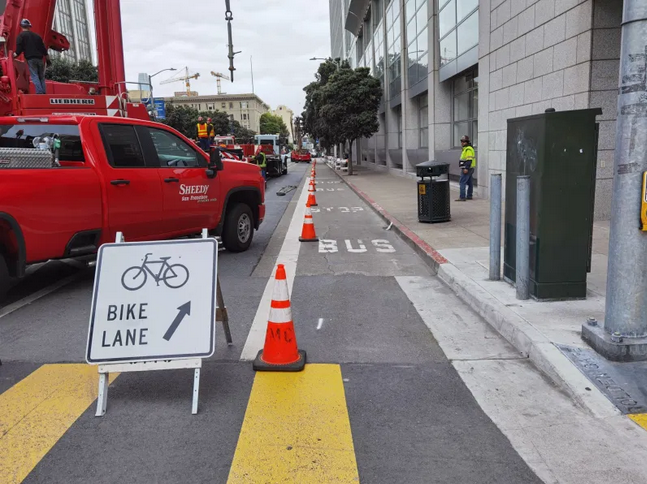Note: GJEL Accident Attorneys regularly sponsors coverage on Streetsblog San Francisco and Streetsblog California. Unless noted in the story, GJEL Accident Attorneys is not consulted for the content or editorial direction of the sponsored content.
The lead image is of a temporary protected bike lane observed this weekend on Golden Gate Avenue between Polk and Larkin. "There was construction with a large Crane blocking the other travel lanes," wrote advocate Parker Day, who brought this to Streetsblog's attention. "SFMTA had someone there directing traffic."
Some of the most dangerous riding in the Bay Area comes at construction sites, where often the only steps crews will take to keep cyclists safe is to put up a "Bicycles Allowed Use of Full Lane" sign. This has been a contentious and dangerous issue for cyclists, with advocates pushing hard for years now to get construction crews to consider cyclist safety when they tear up the pavement or block lanes with equipment.
And while the evidence is as yet anecdotal, as seen in the lead image, the situation seems to be improving.
"In December I saw a similar situation on Illinois St in the Dogpatch. The southbound general travel lane was closed, but they managed to weave a cone-lined bike lane through the construction site," wrote Day. "That one was also one block long. It was particularly cool because of the signage, 'Road Closed/Except Bicycles.'"
But as confirmed by the San Francisco Bicycle Coalition, bike lanes through construction sites are still hit and miss. "We've been pushing hard for better temporary infrastructure during construction for years," wrote an SFBC spokesperson. "It seems that the ability to get better temp infrastructure has to do with who is doing the construction."
"In my experience, it seems to be up to whoever pulls the Special Traffic Permit to propose a shared lane or a protected lane; some companies are better than others in that regard," agreed advocate Dale Munroe, who's made construction and bike lanes a bit of a hobby.
According to SFMTA regulations (provided by Munroe) contractors are supposed to always maintain bike lanes when they do road work. When closing one is necessary, it requires a special permit. If they get the permit, however, it's unclear what they have to do besides putting up a sign that says "Bicycles Allowed Use of Full Lane," which may do more harm than good, since that's always the case and the sign may just confuse some drivers. Still, as the Europeans have shown, if bike safety is a true priority, there's no reason passage through a construction site (or on a detour) shouldn't be made safe too.
Still, when construction crews blow off their obligation to keep cyclists safe, it isn't always clear what to do about it. "SFMTA's parking enforcement phone operators don't know how to forward construction-related reports to the right team that has real authority (serious fines or shutting down the site immediately) even if you ask, and instead they just end up going to PCOs [SFMTA traffic enforcement] who are not equipped to deal with construction and non-vehicular obstructions," said Munroe.
Streetsblog, has reached out to SFMTA, Public Works, and Dominic DeMartini, Safety Director of Sheedy Crane (the contractor in the lead photo) to get more details and more on how construction crews are supervised--and who exactly cyclists can thank for the excellent treatment in the lead image. Look for updates to this post.
And please post about your own experiences navigating construction sites.






